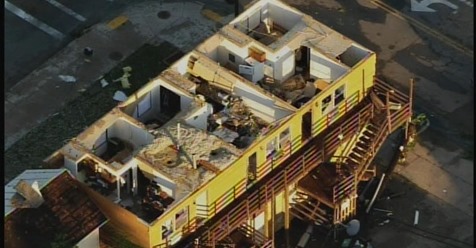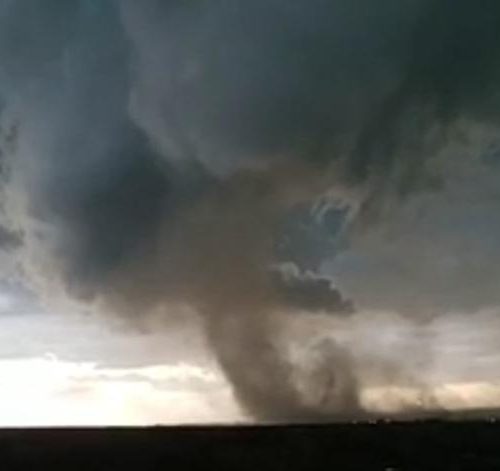First came the rain, lashing down on to the tarmac at Bradley International Airport.
Next were the howling winds. The sky turned black, and Donald J. Piacentini hopped into his car, left his job at the airport in Windsor Locks and headed home to Agawam.
Piacentini was a reluctant witness to the tornado that swept through sections of northern Connecticut 40 years ago this month, on Oct. 3, 1979. He was leaving work just as it touched down in a swirl of devastation.
“It was raining so hard that the aircraft had to wait at the gate. Water was seeping through the doorways of the planes, and the pilots couldn’t move them,” he recalled in 2004 on the 25th anniversary of the storm.
The next morning, Piacentini had a front-row view of the wreckage as he reported for work as a ramp technician at American Airlines.
“The airplanes at the old air museum, there were maybe 25 of them, were all disarranged and upside-down,” he said. “One old cargo plane looked like a big guppy, upside-down. It was a pretty bad sight.”
The Bradley Air Museum, now the New England Air Museum, was wiped out in the tornado that touched down in Connecticut in Windsor Locks, Suffield and the Poquonock section of Windsor, and also across the Massachusetts border in parts of Agawam and Southwick. The swirling winds and pounding rain also demolished a bank, decapitated hundreds of trees, slammed a two-by-four through the window of a truck, and reportedly sent a dog flying backwards.
Three people were killed, and nearly 500 were injured as the F4 tornado hopscotched along an 11-mile path of destruction. When it was done, the tornado would go into the record books as one of the 10 most costly in U.S. history, causing an estimated $200 million in damage (more than $600 million in today’s dollars).
The ruined museum was rebuilt on 58 acres just north of the airport and is presenting a 40th-anniversary exhibit, “8 Minutes: Bradley Air Museum and the Windsor Locks Tornado of 1979,” documenting the tornado’s devastation and how the museum and community recovered. It is on exhibit through June.
The twister was the 61st recorded in almost 300 years of Connecticut weather history. Besides the two deaths, it caused more $214 million worth of damage and more than 400 injuries. The region’s hospitals were beyond busy that night.
Because it brewed in intensity at 2:50 p.m. that day just over the National Weather Service outpost located at the airport, weather experts had no warning.
But meteorologist Curt Osgood, of the Westover Air Reserve Base weather station in Chicopee, was in downtown Springfield that day and remembers well the odd sky that formed to the south of the city.
“I noticed clouds moving in different directions, which is very unusual,” he recalled in 2004. “It was concentrated to the south of us. I didn’t know it, but I was seeing the edge of a tornado.”
Tornadoes are one of nature’s most violent storms, difficult to predict and often expensive to recover from.
They shoot down in a frenzied rotating column of air from thunderstorms and can be capable of wind speeds of up to 300 miles an hour. Damage paths can run wider than a mile and as long as 50 miles, as the region learned well in 2011 when a tornado roared through Western Massachusetts on a 40-mile path of destruction that stretched from Westfield to Sturbridge.
They can occur at any time of year, though in northern states it tends to be during the summer. Tornadoes also usually come from the west with a cold front, making the 1979 twister unusual in that it grew from a storm heading south to north, ahead of a warm front.
In 2004, Osgood, known by his colleagues as “the king of tornadoes,” remembered the recipe for the storm he watched from a distance.
“I read the scientific reports on this one,” he said. “It was moving from the south, with a warm front. There was an intersectional warm front and a trough. It was kind of an unusual situation.”
He likes to read up on specific tornadoes because of “their intense velocity, their ability to translate energy into a small localized area. And they do all that damage,” he said.
About 1,000 are reported each year. Early warning signs are rotating thunderstorms, and anyone who sees such weather is advised to take shelter immediately.
The 1979 tornado rocketed wind speeds from 8 mph to 86 mph in just seconds. At the time, meteorologists said the top wind speeds were much higher, but they were not recorded.
Barometric pressure took a nose-dive, and half-inch hailstones pelted the affected area.
It was in the middle of a line of thunderstorms that extended from Hartford to Springfield, according to weather service radar reports.
After touching the ground in Windsor Locks, the swirling mass moved heavenward as it shot to the north, still strong enough to lift roofs off houses in Agawam, before spinning toward North Adams.
Route 75 in Windsor Locks was a swath of destruction. Aircraft were destroyed, cars were overturned, a restaurant lost its roof, and trees were torn out at the roots.
Checks from a bank in Windsor were later found strewn on the ground in North Adams.
Piacentini remembered driving around the area in the days following. The vista had a surreal quality that he said he would never forget.
“It was incredible, the devastation. We’ve never experienced anything like it,” he said. “It looked like Paul Bunyan just swung his ax on acres and acres of trees. They were all chopped off.”
President Jimmy Carter declared the ruins a disaster area, making victims eligible for federal relief.
by Mary Ellen Lowney | Special to The Republican (2019, Oct 13) Mass Live



